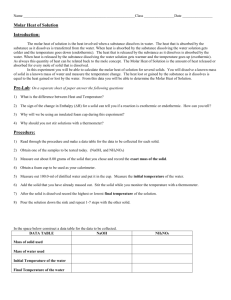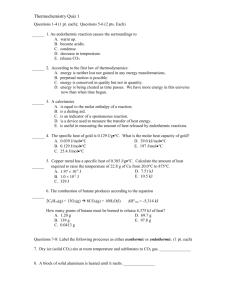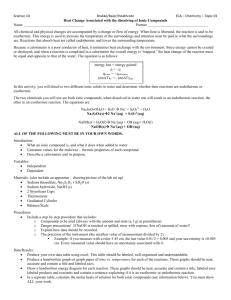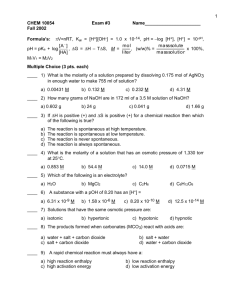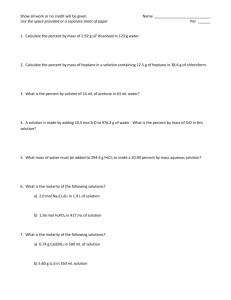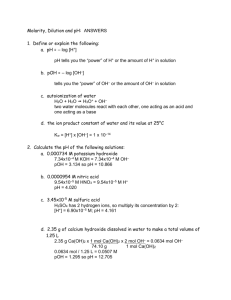Heat of Solution
advertisement
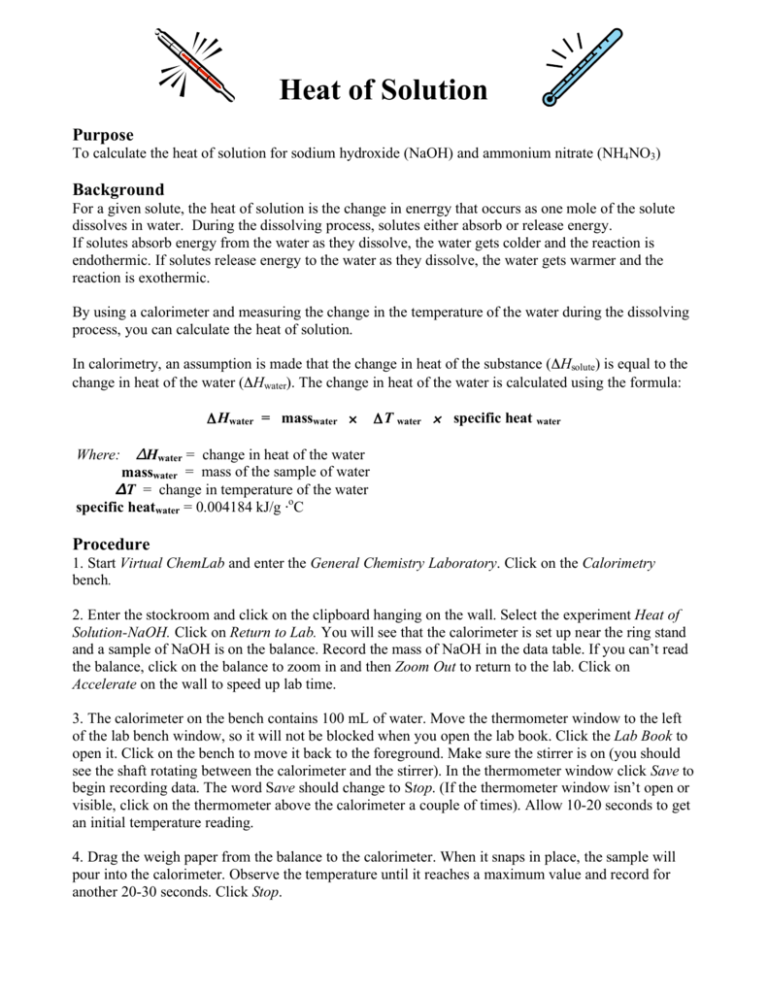
Heat of Solution Purpose To calculate the heat of solution for sodium hydroxide (NaOH) and ammonium nitrate (NH4NO3) Background For a given solute, the heat of solution is the change in enerrgy that occurs as one mole of the solute dissolves in water. During the dissolving process, solutes either absorb or release energy. If solutes absorb energy from the water as they dissolve, the water gets colder and the reaction is endothermic. If solutes release energy to the water as they dissolve, the water gets warmer and the reaction is exothermic. By using a calorimeter and measuring the change in the temperature of the water during the dissolving process, you can calculate the heat of solution. In calorimetry, an assumption is made that the change in heat of the substance (Hsolute) is equal to the change in heat of the water (Hwater). The change in heat of the water is calculated using the formula: Hwater = masswater T water specific heat water Hwater = change in heat of the water masswater = mass of the sample of water T = change in temperature of the water specific heatwater = 0.004184 kJ/g oC Where: Procedure 1. Start Virtual ChemLab and enter the General Chemistry Laboratory. Click on the Calorimetry bench. 2. Enter the stockroom and click on the clipboard hanging on the wall. Select the experiment Heat of Solution-NaOH. Click on Return to Lab. You will see that the calorimeter is set up near the ring stand and a sample of NaOH is on the balance. Record the mass of NaOH in the data table. If you can’t read the balance, click on the balance to zoom in and then Zoom Out to return to the lab. Click on Accelerate on the wall to speed up lab time. 3. The calorimeter on the bench contains 100 mL of water. Move the thermometer window to the left of the lab bench window, so it will not be blocked when you open the lab book. Click the Lab Book to open it. Click on the bench to move it back to the foreground. Make sure the stirrer is on (you should see the shaft rotating between the calorimeter and the stirrer). In the thermometer window click Save to begin recording data. The word Save should change to Stop. (If the thermometer window isn’t open or visible, click on the thermometer above the calorimeter a couple of times). Allow 10-20 seconds to get an initial temperature reading. 4. Drag the weigh paper from the balance to the calorimeter. When it snaps in place, the sample will pour into the calorimeter. Observe the temperature until it reaches a maximum value and record for another 20-30 seconds. Click Stop. 5. A blue data link will appear in the lab book. Click on the link and record the initial and maximum temperature of the water in the data table. 6. Click on the red waste bucket to Cleanup Lab Bench. Return to the Stockroom. Click the clipboard and select the experiment Heat of Solution-NH4NO3. Return to Lab. Repeat the experiment, as per steps 3 and 4 above, but this time with the ammonium nitrate crystals. Note that in this experiment, the temperature of the solution will drop and not rise. Record the mass of the sample, initial temperature of the water and the minimum temperature of the water after the crystals are added. Data Substance Mass (g) Initial Temp. (oC) Final Temp. (oC) NaOH NH4NO3 Calculations 1. For each of the solutes, calculate the change in temperature (T) of the water. NaOH: NH4NO3: 2. Calculate the mass of the 100 ml of water in the calorimeter. The density of water at 25oC is 0.998 g/mL. 3. Calculate the change in heat of the water with each solute. (Hwater = masswater Twater specific heatwater) NaOH: NH4NO3: 4. Calculate the number of moles of each solute. NaOH: NH4NO3: 5. Calculate the molar heat of solution for each solute. (Hsolute/molessolute) Remember: H is positive for endothermic changes and negative for exothermic changes. 6. The accepted value for the heat of solution of NaOH is 44.2 kJ/mol and for NH4NO3, it is 25.4 kJ/mol. Calculate the percent error for each solute. NaOH: NH4NO3: 7. For which of the solutes was the dissolving process endothermic? Exothermic? Heat of Solution Teacher’s Notes This experiment can be done by student when they are studying thermodynamics and calorimetry or solutions. Sample Data and Calculations Substance Mass (g) Initial Temp. (oC) Final Temp. (oC) NaOH NH4NO3 3.9979 2.0222 24.99 25.00 30.05 23.59 Calculations 1. For each of the solutes, calculate the change in temperature (T) of the water. NaOH: 30.05oC – 24.99oC = 5.06 oC NH4NO3: 25.00oC – 23.59oC = 1.41oC 2. Calculate the mass of water in the calorimeter. The density of water at 25oC is 0.998 g/mL. 100 mL 0.998 g/mL = 99.8 g 3. Calculate the change in heat for the water with each solute. (Hwater = masswater Twater specific heatwater) NaOH: Hwater = 99.8 g 5.06oC 0.004184 kJ/g o C = 2.11 kJ NH4NO3: Hwater = 99.8 g 1.41oC 0.004184 kJ/g o C = 0.589 kJ 4. Calculate the number of moles of each solute. NaOH: 3.9979 g/40.00 g/mol = 0.09995 mol NH4NO3: 2.0222 g/80.04 g/mol = 0.02526 mol 5. Calculate the molar heat of solution for each solute. (Hsolute/moles solute) Remember: H is positive for endothermic changes and negative for exothermic changes. NaOH: -2.11 kJ / 0.09995 mol = -21.11 kJ/mol NH4NO3: 0.589 kJ / 0.02526 mol = 23.32 kJ/mol 6. The accepted value for the heat of solution of NaOH is –44.2 kJ/mol and for NH4NO3, it is 25.4 kJ/mol. Calculate the percent error for each solute. NaOH: |44.2-21.22|/44.2 100% = 52.0% error NH4NO3: |25.4-23.32|/25.4 100% = 8.19% error 7. For which of the solutes was the dissolving process endothermic? Exothermic? The dissolving of NaOH is exothermic and the dissolving of NH4NO3 is endothermic.
